



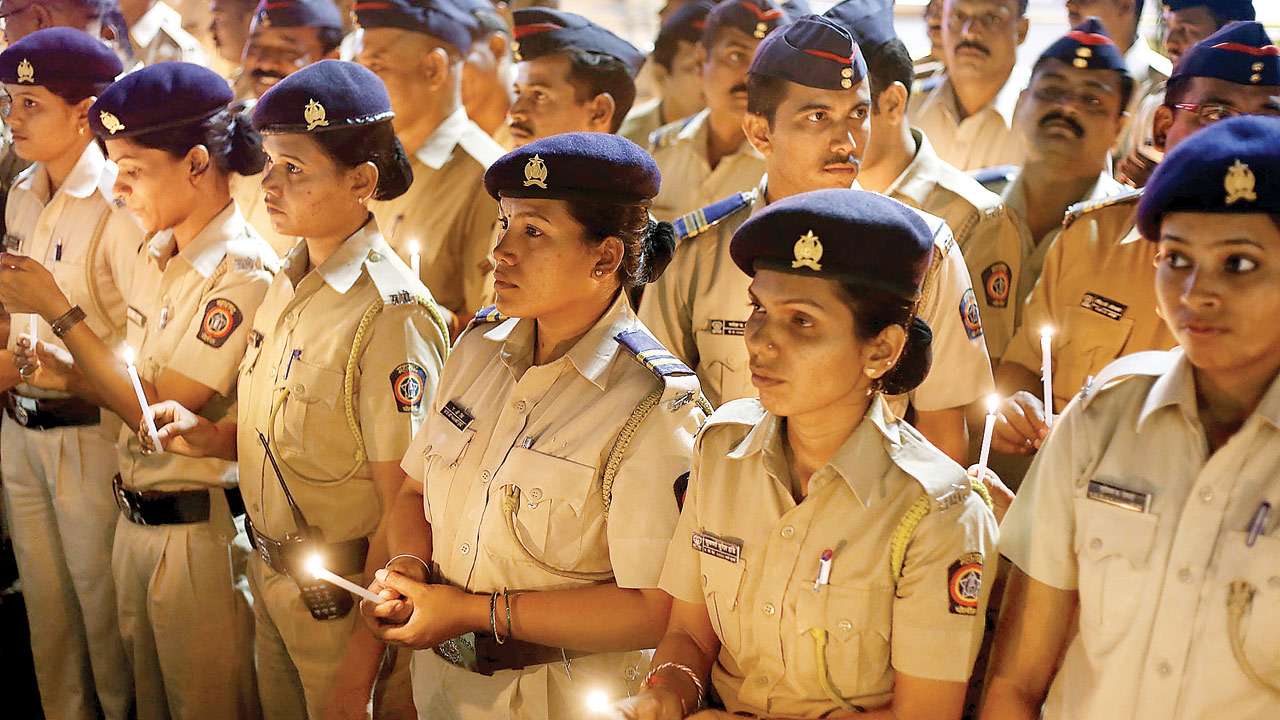
Disclaimer: Copyright infringement not intended.
Introduction
Under the Constitution, police is a subject governed by states. Therefore, each of the 29 states have their own police forces. The centre is also allowed to maintain its own police forces to assist the states with ensuring law and order. Therefore, it maintains seven central police forces and some other police organisations for specialised tasks such as intelligence gathering, investigation, research and record-keeping, and training.
The primary role of police forces is to uphold and enforce laws, investigate crimes and ensure security for people in the country. In a large and populous country like India, police forces need to be well-equipped, in terms of personnel, weaponry, forensic, communication and transport support, to perform their role well. Further, they need to have the operational freedom to carry out their responsibilities professionally, and satisfactory working conditions (e.g., regulated working hours and promotion opportunities), while being held accountable for poor performance or misuse of power.
Police system in India
The state and central police forces have varied roles. Local concerns, such as crime prevention and investigation, as well as preserving peace and order, are generally handled by state police agencies. The central forces are specialised in dealing with such confrontations, and they also provide the initial response in the event of more serious internal security threats. The centre is in charge of law enforcement throughout the seven union territories.
State police force
Numerous state police forces are governed by their respective state laws and regulations. Some states have modelled their legislation after the Police Act of 1861, which is a federal law. States also have police manuals that define how the state’s police are organised, their roles and responsibilities, and the records that must be kept.
The two arms of state police forces are – civil and armed.
The civil police are in charge of maintaining peace and order and preventing crime on a daily basis. Armed police are maintained on standby until emergencies, such as riots, necessitate further reinforcement.
A police station is headed by the inspector or the sub-inspector. The state police forces are under the administration and supervision of the state government. The district magistrate (DM) can also provide directives to the Superintendent of Police (SP) and monitor police administration at the district level. At the district level, this is known as the dual system of control (since authority is shared between the DM and the SP). In some urban areas, the commissioner system is followed whereby there is a unified command structure with the Commissioner of Police as the sole head.
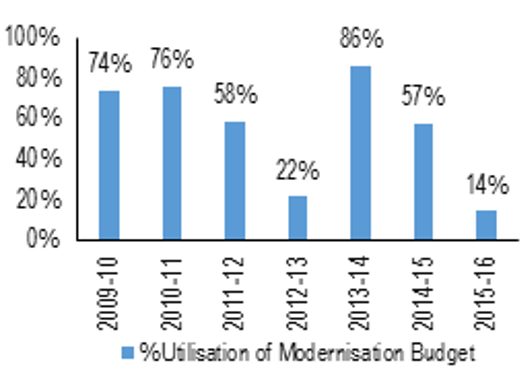
Central Police Force
Various central armed police and paramilitary forces are maintained by the centre. These forces are Assam Rifles (AR), Border Security Force (BSF), Indo Tibetan Border Police Force (ITBP), Sashastra Seema Bal (SSB), Central Industrial Security Force (CISF), Central Reserve Police Force (CRPF), and National Security Guards (NSG).
The responsibilities of the state and central police forces are different. State police forces are primarily in charge of local issues such as crime prevention and investigation, and maintaining law and order. While they also provide the first response in case of more intense internal security challenges (e.g., terrorist incident or insurgency-related violence), the central forces are specialised in dealing with such conflicts. For example, the Central Reserve Police Force is better trained to defuse large-scale riots with least damage to life and property, as compared to local police. Further, the central forces assist the defence forces with border protection.
The centre is responsible for policing in the seven union territories. It also extends intelligence and financial support to the state police forces.
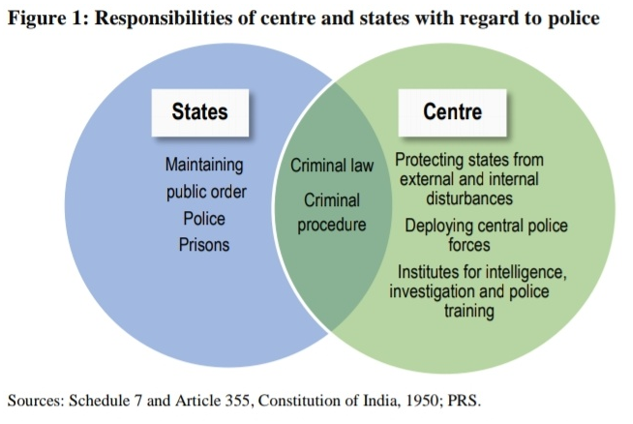
Overview of Crime in India
In 2015, National Crime Records Bureau recorded over 73 lakh complaints of cognizable crimes. Cognizable crimes are relatively serious offences for which police officers do not need a warrant from the magistrate to investigate, such as murder and rape. Between 2005 and 2015, Crime Rate (i.e., crime per lakh population) for cognizable crimes has increased by 28% from 456 complaints per lakh persons to 582 per lakh persons. This has been primarily because of increase in crime rates of alcohol-prohibition crime, theft, kidnapping and abduction, crimes against women and cheating.
Crime Rate for various kinds of crimes under the Indian Penal Code, 1860 and some special laws (per lakh population)
Note: Crime rate for crimes against women (e.g., rape, cruelty by husband or his relatives, insulting modesty of a woman) is calculated per lakh population of women.
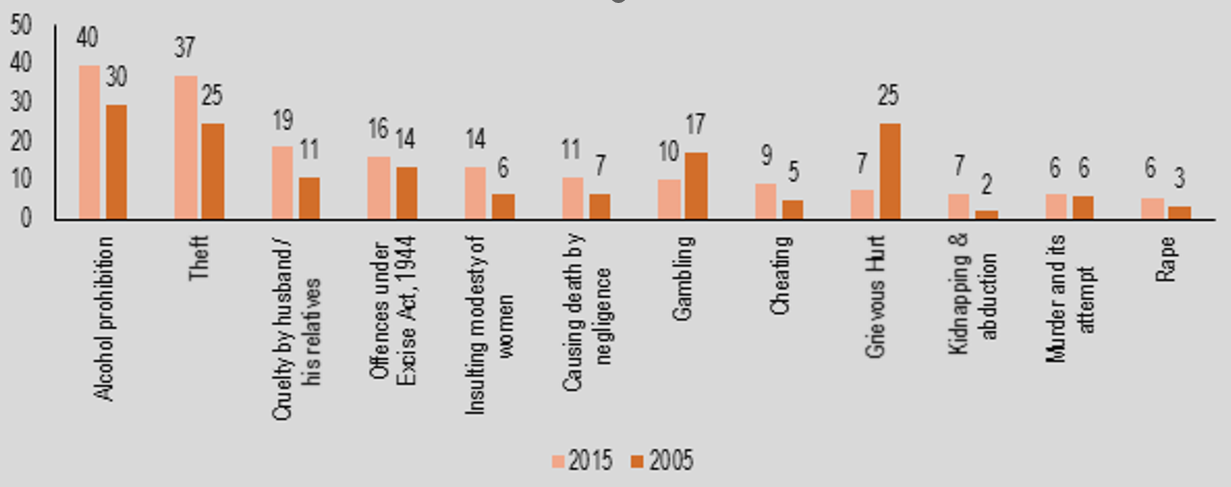
Sources: National Crime Records Bureau; PRS.
Problems faced by the police force
While India is renowned as the world’s largest democracy, little is known about how it has managed to police such a large, complicated, and unpredictable nation. The police forces, therefore, face problems and obstacles while carrying out their functions on a day-to-day basis. Some of the major problems faced by the Indian police system are discussed in the below-mentioned sections.
Overburdened force and vacancies
There are several vacancies in state police forces and some central armed police units at the moment. The overall sanctioned strength of state police forces in India was 22,80,691 as of January 2016, with 24% vacancies (that is, 5,49,025 vacancies). A high percentage of vacancies in police departments exacerbates an already-existing problem of overworked officers.
Police officers perform a variety of tasks including crime prevention and response, internal security and law and order, and a variety of other responsibilities (e.g., traffic management, disaster rescue, and removal of encroachments).
Given India’s low police strength per lakh population in comparison to international standards, each police officer is also responsible for a huge group of people. India’s sanctioned strength is 181 police per lakh people, compared to the UN’s suggested standard of 222 police per lakh people. As a result, the average police officer ends up with a massive burden and extended working hours, which hurts his or her efficiency and performance.
Understaffing leads to overburdening of work, which not only reduces the effectiveness and efficiency of police officers (leading to poor investigation quality) but also causes psychological distress (which has been blamed for a variety of crimes committed by officers) and contributes to case pendency.
Infrastructure
Modern policing necessitates effective communication, cutting-edge or modern weapons, and a high level of mobility. On numerous of these fronts, the CAG (Comptroller and Auditor General of India) and the BPRD (Bureau of Police Research and Development) have found flaws. The weapons used by lower police forces are obsolete and cannot match modern weaponry used by anti-social elements.
The CAG discovered that numerous state police departments’ weaponry is archaic, and the purchase process for firearms is lengthy, resulting in a scarcity of arms and ammunition. Police vehicles are in limited supply, according to audits. New automobiles are frequently employed to replace older vehicles, and drivers are in short supply. This has an impact on the police’s response time and, as a result, their effectiveness.
The central government launched the POLNET (Police Telecommunication Network) project in 2002 to connect the country’s police and paramilitary forces through a satellite-based communication network that will be substantially faster than the current radio communications system. However, audits have revealed that the POLNET network is non-operative in various states.
Both the federal government and the states contribute to the modernization of state police forces. This money is often used to improve police infrastructures, such as building police stations and purchasing weapons, communication equipment, and vehicles. However, the underutilization of modernization money has remained a recurrent issue.
Relationship between police and the public
The police-public relations relationship, which is crucial to effective policing, is troubled by a severe lack of confidence. To avoid crime and disturbance, police need the community’s trust, collaboration, and assistance. In each crime investigation, police officers, for example, rely on community people as informants and witnesses. As a result, effective policing requires a strong focus on police-public relations.
Most people believe police to be abusive and also believe that police personnel misuse their power. This leads to the problem of less coordination due to which the police find it improbable to perform their functions.
The Second Administrative Reforms Commission has noted that police-public relations is in an unsatisfactory state because people view the police as corrupt, inefficient, politically partisan and unresponsive.
Investigation of crime
Crime investigation is a basic role of state police forces and some central police agencies, such as the CBI (Central Bureau of Investigation). When a crime is committed, police officers must file a complaint, acquire evidence, identify the perpetrator, construct charges against him, and aid in his prosecution in court in order to secure a conviction. The quality of crime investigation has reduced due to higher crime rates, low conviction rates, several vacancies, and overburdened police staff.
Crime investigation involves forensic capabilities and infrastructure, as well as skills and training, time and resources.
The police do not have the necessary training or expertise to undertake professional investigations. They also lack legal understanding (on issues such as the admission of evidence), and their forensic and cyberinfrastructure is both weak and antiquated.
Another reason for the lack of quality in the investigation is the transfer of officers during the investigation which causes delay and the newly appointed officer needs to study the case and restart the investigation process.
Police accountability
Both the central and state police forces are under the supervision and control of political executives, according to the police statutes. Police priorities are constantly changed at the request of political leaders. This obstructs police officers’ ability to make professional decisions (e.g., how to respond to law and order situations or conduct investigations), leading to biased performance of tasks.
This leads to a lack of accountability of the police and to a misuse of power to abide by the political ideologies.
SOME INSIGHTS
Police accounts for about 3% of government spending
24% vacancies in state forces; 7% in central forces
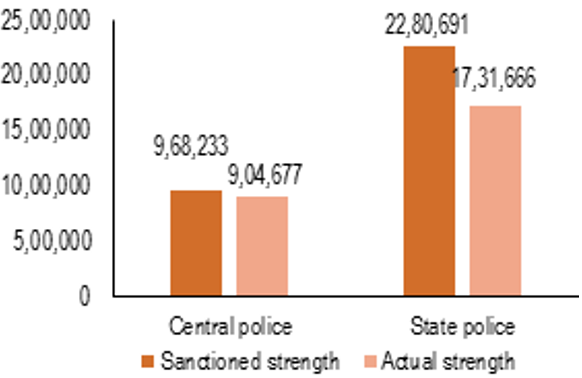
Sources: Bureau of Police Research and Development; PRS
An overburdened police force
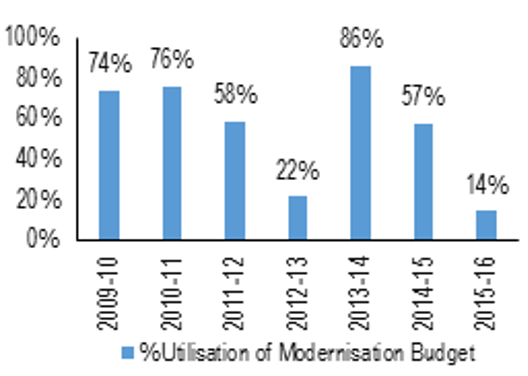
Holding police accountable
Underreporting of crime in India
The National Crime Records Bureau (NCRB) under the Ministry of Home Affairs is the nodal agency for collection and dissemination of information related to crime in India. The NCRB publishes an annual report called Crime in India, that records crime on the basis of the FIRs registered in the police stations across the country. It is the only official source of crime data in India, and it records among other things crime committed state-wise and offence-wise (e.g., murder, rape, cheating, theft).
An expert committee under the Ministry of Statistics and Programme Implementation has noted that there is significant under-reporting of crimes under the NCRB for various reasons. For example, there could be suppression of data and low registration of crimes because the police know that their work is judged on the basis of this information. Also, sometimes victims of crime may decide against reporting the incident with the police because they are afraid to approach the police, or think the crime is not serious enough, etc. Also, note that the NCRB follows the ‘principal offence rule’ for counting crime. This means that if many offences are covered in a single registered criminal case, the NCRB will only count the most heinous of the offences. For instance, a case of murder and rape, will only be counted as a case of murder (i.e. principal offence) by the NCRB.
Constabulary related issues
The Padmanabhaiah Committee and the Second Administrative Reforms Commission have noted that the entry level qualifications (i.e. completion of class 10th or 12th in many states) and training of constables do not qualify them for their role. One of the recommendations made in this regard has been to raise the qualification for entry into the civil police to class 12th or graduation. It has also been recommended that constables, and the police force in general, should receive greater training in soft skills (such as communication, counselling and leadership) given they need to deal with the public regularly.
Promotions and working conditions: The Second Administrative Reforms Commission has further noted that the promotion opportunities and working conditions of constables are poor, and need to be improved. Generally a constable in India can expect only one promotion in his lifetime, and normally retires as a head constable, which weakens his incentive to perform well. This system may be contrasted with that in the United Kingdom, where police officers generally start as constables and progress through each rank in order. Further, in India sometimes superiors employ constables as orderlies to do domestic work, which erodes their morale and motivation, and takes them away from their core policing work. The Commission recommended that the orderly system be abolished across states.
Status of Policing in India Report 2019
Status of Policing in India Report 2019 by Common Cause and Centre for the Study Developing Societies, highlights the dismal work conditions in which the police operate in the country.
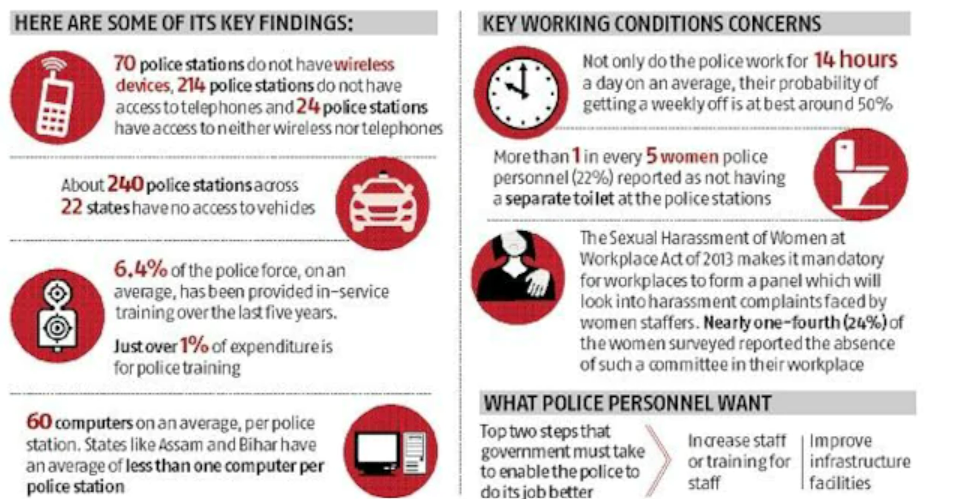
Solutions
Many bodies like the Second Administrative Reforms Commission, the Law Commission and the Padmanabhaiah Committee have suggested reforms and policies that could be implemented to tackle the above problems.
Outsourcing and redistributing functions
The Second Administrative Reforms Commission has recommended that some non-core police duties (such as traffic control, disaster rescue and relief, and the issuance of court summonses) could be outsourced or redistributed to government departments or private entities as a measure to relieve the strain on police forces. Other agencies may undertake these responsibilities because they do not necessitate any unique policing skills. This will also allow police departments to devote more time and resources to their primary policing responsibilities.
Specialised investigating units
To ensure better functioning of the police when it comes to investigating, the Law Commission suggests the setting up of separate and specialised investigating units within the police force which are solely responsible for the investigation of crimes.
Limiting the political executive’s power of superintendence over police forces
Various experts have advocated that the political executive’s role of supervision over police forces be restricted to enable the police to be more operational and independent while still ensuring accountability.
According to the Second Administrative Reforms Commission, this jurisdiction should be limited to boosting professional efficiency and ensuring that police officers follow the law.
The Supreme Court and the Second Administrative Reforms Commission have both stated that an independent complaints authority is needed to investigate allegations of police misconduct and ensure accountability.
Directions of the Supreme Court in Prakash Singh v. Union of India (2006)
In 1996, a petition was filed with the Supreme Court alleging that police officers abuse and misuse their authority. The court issued numerous directives to the federal government and the states in September 2006. The following are the guidelines:
Community Policing Model
One of the ways of improving Public-Police Relationship is through the community policing model. Community policing requires the police to work with the community for prevention and detection of crime, maintenance of public order, and resolving local conflicts, with the objective of providing a better quality of life and sense of security. It may include patrolling by the police for non-emergency interactions with the public, actively soliciting requests for service not involving criminal matters, community based crime prevention and creating mechanisms for grassroots feedback from the community. Various states have been experimenting with community policing including Kerala through ‘Janamaithri Suraksha Project’, Rajasthan through ‘Joint Patrolling Committees’, Assam through ‘Meira Paibi’, Tamil Nadu through ‘Friends of Police’, West Bengal through the ‘Community Policing Project’, Andhra Pradesh through ‘Maithri and Maharashtra through ‘Mohalla Committees’.
|
Examples of community policing in India Janamaithri Suraksha in Kerala This project is an initiative of the Kerala Police to facilitate greater accessibility, close interaction and better understanding between the police and local communities. For example, Beat Constables are required to know at least one family member of every family living in his beat area, and allocate some time to meet with people outside the police station every week. Janamaithri Suraksha Committees are also formed with municipal councillors, representatives of residents’ associations, local media, high schools and colleges, retired police officers, etc. to facilitate the process. Meira Paibi (Torch-bearers) in Assam The women of the Manipuri Basti in Guwahati help with improving the law and order problem in their area, by tackling drug abuse among the youth. They light their torches and go around the basti guarding the entry and exit points, to prevent the youth of the area from going out after sunset. Sources: Model Police Manual, Bureau of Police Research and Development; Kerala Police Website; PRS. |
Independent Complaints Authority
The Second Administrative Reforms Commission and the Supreme Court have observed that there is a need to have an independent complaints authority to inquire into cases of police misconduct. This may be because the political executive and internal police oversight mechanisms may favour law enforcement authorities, and not be able to form an independent and critical judgement.
For example, the United Kingdom has an Independent Office for Police Conduct, comprising of a Director General appointed by the crown, and six other members appointed by the executive and the existing members, to oversee complaints made against police officers. Another example is that of the New York City Police which has a Civilian Complaint Review Board comprising of civilians appointed by local government bodies and the police commissioner to investigate into cases of police misconduct.
India has some independent authorities that have the power to examine specific kinds of misconduct. For example, the National or State Human Rights Commission may be approached in case of human rights violations, or the state Lokayukta may be approached with a complaint of corruption.
However, the Second Administrative Reforms Commission has noted the absence of independent oversight authorities that specialise in addressing all kinds of police misconduct, and are easily accessible. In light of this, under the Model Police Act, 2006 drafted by the Police Act Drafting Committee (2005), and the Supreme Court guidelines (2006), states are required to set up state and district level complaints authorities.
Model Police Act, 2006Key features of the Model Police Act, 2006 include: Organisation and recruitment: Each state will have one police service, which shall be headed by the DGP. Direct recruitments to subordinate ranks (i.e. below Deputy SP) will be made through a state level Police Recruitment Board. Recruitment to officers’ ranks will be through the Union Public Service Commission or State Public Service Commission. Responsibilities: The responsibilities of the police serve will include: (i) enforcing the law impartially, and protecting life, liberty and human rights, (ii) preserving public order, and preventing terrorist, militant and other activities affecting internal security, (iii) protecting public properties, (iv) preventing and investigating crimes, (v) providing help in natural or man-made disasters, (vi) collecting intelligence, etc. In police stations in urban areas and crime prone rural areas, investigation of heinous and economic crimes (e.g., murder, serious cases of cheating) will be carried out by a Special Crime Investigation Unit, headed by an officer at least of the rank of a Sub-Inspector. Officers of these units will generally not be diverted for any other duty. Accountability: The state government will exercise superintendence over the police service. This will include laying down policies and guidelines, setting standards for quality policing, and ensuring that the police perform their duties in a professional manner. State Police Boards will be constituted in each state to frame guidelines, select officers who are qualified to be promoted to rank of DGP, and evaluate police performance. Police Accountability Commissions will also be set up by states to address complaints of police misconduct. However key police functionaries (e.g., DGP and police station in charge) will have a minimum tenure of two years unless they have been convicted by a court, or suspended from service, etc. Service Conditions: The state government will ensure that the average hours of duty of a police officer do not exceed 8 hours (in exceptional situations, 12 hours). Adequate insurance coverage will also be provided to personnel against any injury disability or death caused in line of duty. A Police Welfare Board must also be set up to administer and monitor welfare measures for police, including medical assistance, group housing, and legal aid for officers facing court proceedings. |
Operational Freedom to Police
To allow the police greater operational freedom while ensuring accountability, various experts have recommended that the political executive’s power of superintendence over police forces be limited. The Second Administrative Reforms Commission has recommended that this power be limited to promoting professional efficiency and ensuring that the police is acting in accordance with law. Alternatively, the National Police Commission (1977-81) suggested that superintendence be defined in the law to exclude instructions that interfere with due process of law, or that influence operational decisions, or unlawfully influence police personnel transfers, recruitments, etc. The Supreme Court has also issued directions to states and the centre in 2006 in this regard.
Conclusion
The current state of affairs in the country places a great deal of responsibility on state police administrations. The established system is clearly unprepared to handle the pressures of the circumstance. The police system in a democracy like India plays a very important role in enforcing the laws in the country. Therefore, such an important limb of the Government needs to be concentrated on more and several reforms must be made in order to make sure the smooth functioning of the system.
The solution depends on innovative thinking within state police administrations and on the part of police leadership to meet the challenge of the new political and administrative ideologies of democracy, socialism, secularism, and nationalism, as enshrined in the Constitution of India amendments.
Individual states must make sure the problems faced by the police are done away with at the earliest. State legislation must take into consideration the guidelines which were suggested by the Supreme Court in the case of Prakash Singh vs Union of India and respectively form their laws and guidelines.
© 2025 iasgyan. All right reserved